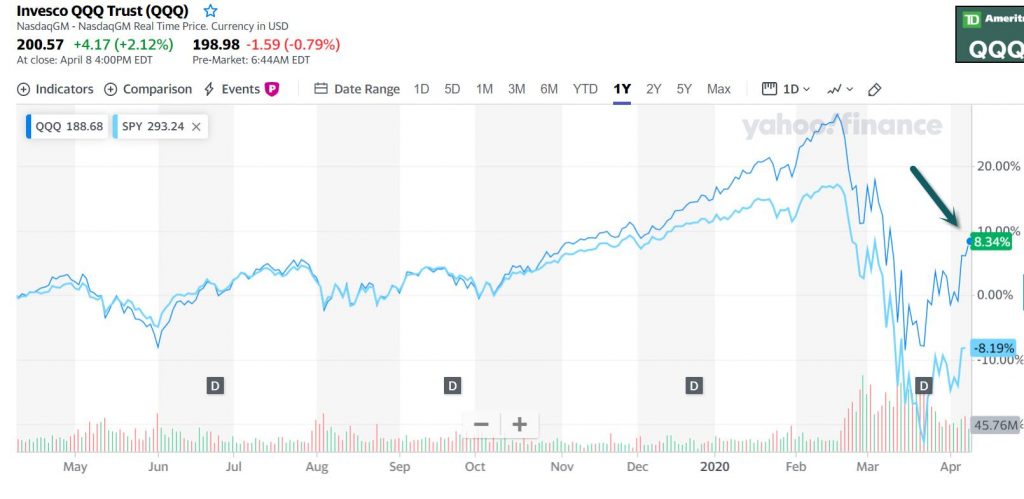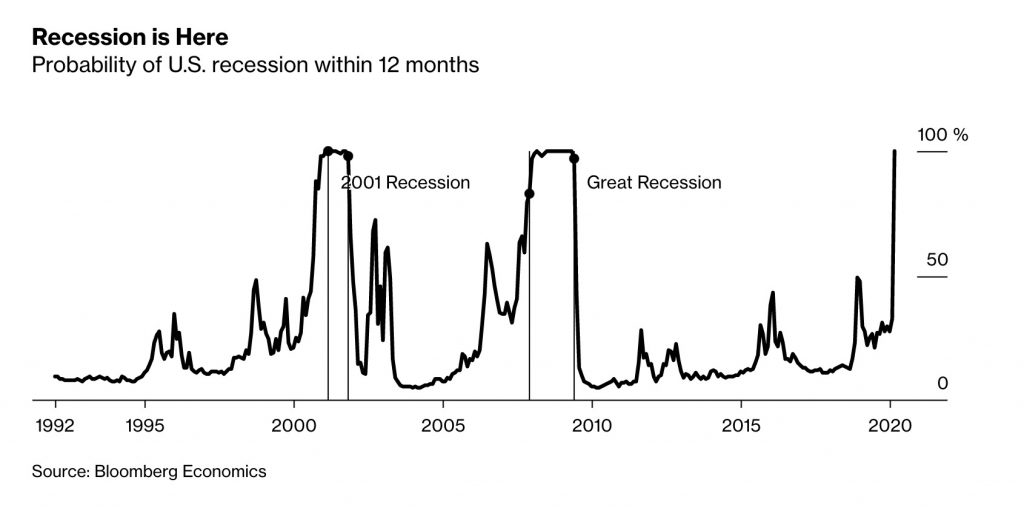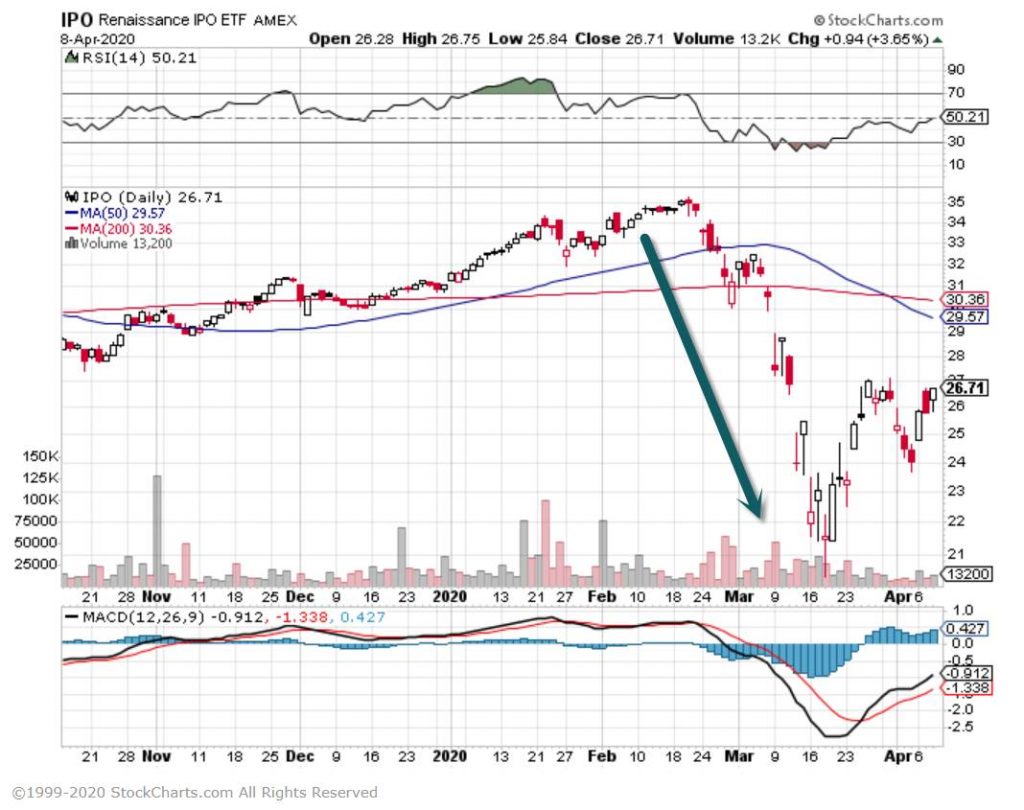1.Yesterday TSA checked 97,130 air travelers. A year ago it checked 2,091,056 air travelers-Stat from Dave Lutz at Jones
Last year’s numbers at major hubs

https://www.latimes.com/business/story/2019-08-16/tsa-airport-security-wait-times-drop-lax-analysis
2.Bigger Crash than 1929 and 1987….Tech Stocks 12 mos. Numbers Positive.
QQQ 1 year +8%

Nasdaq Composite Flat 1 Year.
3.Bloomberg Probability of a Recession Model at 100%
Chance of Recession Within 12 Months. Bloomberg Economics created a model last year to determine America’s recession odds. The chance of a recession now stands at 100%, confirming an end to the nation’s longest-running expansion.

https://www.bloomberg.com/graphics/us-economic-recession-tracker/
4.Sectors Performance During Recessions.
Capital Group

Preparing for the next recession: 9 things you need to know-Jared Franz-Darrell Spence
https://www.capitalgroup.com/advisor/insights/articles/guide-to-recessions.html
5. Would You Rather: Buy Too Early or Buy Too Late in a Bear Market?
Posted April 4, 2020 by Ben Carlson
I’ve looked at the returns from the bottom of a bear market and the fact that the gains coming out of the bottom tend to be strong but a comment on Twitter this week caused me to look at this from a different angle.
Had you bought 3 months early during these previous bear markets, roughly half the time you would have been made whole and then some 3 and 6 months later. This also means roughly half the time had you bought 3 months early you would not have been made whole 3 and 6 months later.
What do the returns look like in the 3 months before stocks bottom in a bear market?

A Wealth of Common Sense Full Read
6.See Both Russia and U.S. Massive Historical Increase in Oil Production.

7.IPO ETF
IPO -40% drop at bottom of crash same as small cap index

8.PE Ratio Comparisons for 10 Years-Emerging Markets Hit 2003 Levels and Developed International Close to All-Time Lows.
Follow
This chart has been in my investment strategy tool kit from the early days, and it is both simple and powerful. It shows the PE10 valuation indicator for the major chunks of global equities: USA, Emerging Markets, and Developed Markets excluding USA. The upshot is after trading to expensive levels, US equities have returned to more neutral levels (but more on the US market later in this article). Perhaps more interestingly though is the valuation gap that existed previously between US and global ex -US, which has persisted through the crash (and is something I have documented extensively. The other key observations to note are 1. how the EM PE10 briefly traded as low as 2003 levels; and 2. the DM ex-US PE10 almost broke to a new all time low. For investors who use valuation in their process, things are getting interesting! Read more: https://lnkd.in/fRzGjFU
https://www.linkedin.com/company/topdown-charts/
9.Cares Act Notes.

Courtesy of Goldman Sachs Research
10.8 Steps to Have a Good Day When Working Remotely
Whether you are a member of senior management or a few months into your startup, these strategies can help you look forward to your workday.
By John E. DiScalaFounder and CEO, Johnny Jet@JohnnyJet
small-business owner or an aspiring entrepreneur hoping to turn your side hustle into a startup, having a bad start to the workday can take a toll.
As simple as it may sound, there are ways to overcome a bad day (or bad series of days) and maintain your productivity. While a bad day is sometimes a response to something out of your control, the good news is you do have control over what you can do about it.
Here are a few ways to have a good and positive day, regardless of what is going on in the world around you.
1. Put your phone aside.
Instead of checking your phone first thing in the morning, try breathing exercises, journaling, or meditation. If you use your phone as an alarm clock, keep it away from your bed so that you’ll have to get up to turn it off. Once it’s off, resist the urge to check for a few minutes.
Giving yourself a few moments to welcome the morning can make a major difference in how you approach your day. Even better, open your curtains to let some sunlight in. I’ll even stick my head out the window during the early morning. It makes a difference.
2. Give your morning structure.
You shouldn’t be stressing or rushing due to little things taking up your time. Plan out your morning the night before by laying out your clothes, making your lunch (even when working from home), leaving the coffee machine ready to brew, etc.
3. Create a positive morning routine.
Aim to watch or listen to something uplifting or energetic as you get ready to start your day. If you like to listen to the news, try to limit how much you are taking in. Set limits.
I like to start my day by drinking a glass of water, stretching, showering, and then putting on a meditation podcast as I make coffee and get dressed. Then I’ll check the news for a few minutes (any longer and it feels overwhelming).
4. Use your body to boost your energy.
Use body language to help you feel more confident and ready for the day. For instance, standing or sitting tall with your chin up can help you feel more assertive and powerful. And even if you’re smiling to yourself, a friendly smile (especially when you don’t feel like smiling) can help keep your spirits up.
Also, when working remotely, try to avoid working from your bed or the couch, if you can. It’s easy to have bad posture and less concentration when working away from a traditional table and chair.
5. Give yourself goals.
Sometimes your day gets so busy that you get overwhelmed with all of the tasks left to complete. To help stay on track, write out three goals for the day. Try to keep them simple, but necessary and achievable.
Perhaps you can work on two small things and one big thing. While getting the most important task done is the goal, if you can’t get to it, at least crossing off small tasks can feel like a relief.
Knocking out those three goals by lunchtime is ideal, but if you haven’t gotten to them by noon, you can at least prioritize and plan for the rest of your day. Overall, the goal is to have checked off something on that list before clocking out.
6. Take a break.
Take breaks and eat your lunch away from your desk, preferably near a window, or outside if you can. Try to give yourself designated spaces that are meant for specific purposes. If you can eat near a window and get some sunshine for a few minutes, you can help avoid that midday slump.
If you’re ordering food, note that are are credit card benefits for eating at home that include free delivery.
7. Do something nice for someone.
Volunteering to help someone can boost your energy and help you feel connected–so long as you don’t have a self-serving ulterior motive. Something as simple as sharing positive feedback and checking in with employees to see how they’re doing can make a difference.
8. Set office hours.
It can be easy to keep working until late when working remotely. Just as you would in an office, put your work away when it’s closing time. Put your computer to the side for another day. I also find it helpful to reflect on what I accomplished that day.
PUBLISHED ON: APR 6, 2020
The opinions expressed here by Inc.com columnists are their own, not those of Inc.com.
More from Inc.
https://www.inc.com/john-discala/8-steps-to-have-a-good-day-when-working-remotely.html?cid=sf01003
Matthew Topley



